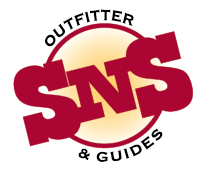Handling Your Wild Game Meat
You have successfully filled your Wyoming hunting license with SNS Outfitter & Guides. Congratulations! Now that the climax of your hunt has been reached, the next thought on your mind may very well be:
How will my wild game meat be handled?
Additionally:
- Will my guide field dress my animal?
- How does it get transported to the meat cutter?
- Will it be processed in time for me to take it all home?
- Packing?... Pounds?... Cuts & Coolers? ...
Rest assured! After 45+ years of serving hunters, our team of professionals has all the details covered. Once again from the SNS Outfitter classroom, we are pleased to provide you with some reassurance and this answer key. When it comes to all the little details, logistics and creature comforts of a big game hunting adventure, no one beats the experience of SNS Outfitter & Guides.
Breaking it down into one cut at a time, let's begin this question & answer with:
Q: How will my meat be handled in the field?
A: Once your animal is down the next task at hand is of course, field dressing your animal. SNS' professional guides are all trained on the best techniques and will take the lead on field dressing or quartering the animal depending on the conditions and size of your kill. Your assistance is always welcomed and guides will often ask you to hold a leg while they cut.
Antelope are generally gutted, then loaded and taken to the processor whole with the hide left on to protect the meat from dirt & debris.
Elk, being much larger, are quartered in the field. Those quarters are loaded on either pack horses or into 4x4 vehicles and transported back to camp.
Deer are usually gutted and removed from the field whole. If killed in a remote area, however, they will need to be quartered to facilitate removal from the field.
Q: How will my meat be transported to the meat processors?
A: This varies from camp by camp. On some of our hunts we take the animals directly to the processor as we harvest them. Elk may either be taken by SNS staff to the processor or in the case our wilderness hunts, clients are required to bring coolers to the trail-head and take the elk quarters to a processor of their choice or home to be processed. If you ever feel as though you need clarification on how your meat will be handled, please don't ever hesitate to give us a call with your inquiry.
Q: Will processing be done in time for me to take my meat home with me?
Q: How many pounds of meat can I expect to get out of my animal?
A: This will vary widely and depends on many factors such as which species you are hunting, along with its size and age. Additionally, shot placement will be a huge factor. A clean shot through the chest is by far the best option for maximizing the amount of meat you will have. There is really no hard and fast answer to what amount of meat you can expect to receive, but, of course, our hope is that you have plenty of wild game to enjoy with your family & friends all year long.
Q: How will my meat be packaged?
A: For the most part, meat processors have adopted vacuum sealed packaging. This allows meat to be kept safely in your deep freezer for up to 18 months.
Q: What are the options of cuts for my meat?
A: How your meat is processed is a personal preference. You will be provided with many options such as sausages, jerky, hamburger with beef fat added it and so on. It's best to cook your elk or antelope just the same as you would venison taken at home.
Q: Will my meat fit in a cooler?
A: One large cooler will easily fit an antelope or deer either processed or unprocessed quarters. Elk typically will require 2 large coolers if you are planning on transporting unprocessed quarters home with you. A processed cow elk or calf will fit in a single cooler and bull elk will most likely still require two coolers.
Q: Is there an option to ship my meat home?
A: The answer is yes! Shipping your harvested meat home is the best option if you are limited on time or flying home.
Q: Is it possible to donate your meat to a local food bank?
A: Meat shops can process your wild game and package it to be donated to those who are in need. This is a great gesture and speaking from personal experience, a very rewarding option indeed. If you choose to donate your meat, you are still responsible for payment of the processing.
Alright, that likely covers all of your frequently asked question on the topic of handling your meat when you embark on a hunt with SNS Outfitter & Guides. If we missed anything though, please leave a comment below on the video or contact our staff at the SNS headquarters with your inquiry. We are looking forward to kicking off your hunt and welcoming you out west for a big game hunting adventure you won't soon forget!
To learn more about a hunt with SNS Outfitter & Guides, please visit the website: www.HuntWyo.com call 1-307-266-4229 or email
Want more?
See past blog posts on the SNS Blog.
SNS Outfitter & Guides is a permittee of the Bridger Teton National Forest, Greys River District & Thunder Basin National Grasslands as well as the Bureau of Land Management.
Outfitter Web Site Design by Waves Web Design.

